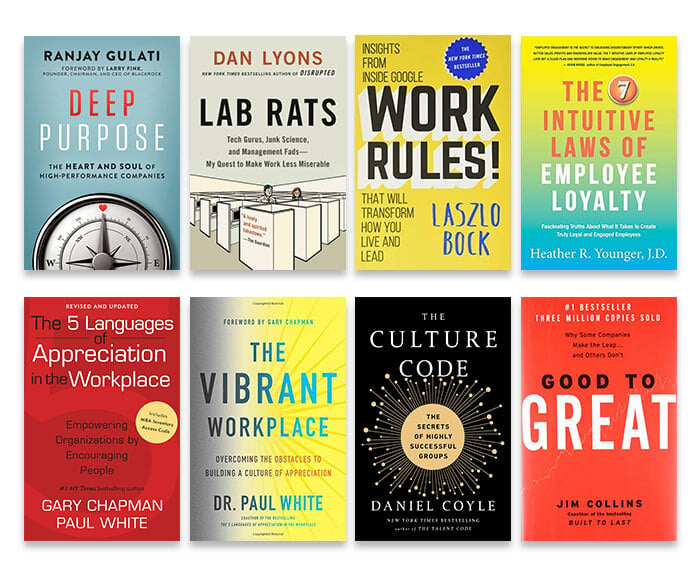If you've read some of our articles before, you may know that I'm the main content writer at Applauz. I've been writing for the HR space for almost three years now. While I've never worked in HR myself, I have a bachelor's degree in psychology, and I spend my days researching and reading about work, management, and organizational psychology.
As such, I strive to learn and share knowledge from HR experts and thought leaders. That's why I have also read several books about work and employee engagement for our quarterly series Applauz Book Club.
Among some of the titles I've read:

As I read several books, I noticed that they shared many of the same thoughts and ideas.
What's more interesting is that many of these core ideas are actually counterintuitive; they rub up against our commonly held beliefs and assumptions about work and how the workplace should operate. Perhaps this is why so many organizations fail to implement them.
Ultimately, it's clear there are a few fundamental principles that contribute to high employee engagement and, ultimately, organizational success. This article aims to summarize these core themes from our Book Club books in one place.
The major themes are:
- Employee empowerment and autonomy are central to engagement
- Visible signs of hierarchy harm internal motivation
- Establishing a clear, long-term goal is critical for engagement and growth
- Vulnerability and openness produce high performing teams
- Fostering safety and security are central to employee happiness
Each section will dive a little deeper to describe how this idea is presented by each author. If any of these themes grab your attention, don't forget to check out the book summaries on our Book Club page here.
5 Lessons Applauz Book Club Taught me About Employee Engagement
Employee empowerment and autonomy are central to engagement
We all know how difficult it is to work with bossy micromanagers. But I'm speaking about rigidity on a higher level here. For example, the type of cumbersome bureaucracy that requires multiple approvals for something simple to get accomplished.
Many people may assume these structures are necessary to ensure order and accountability, especially in larger organizations.
Yet, time and time again, throughout several books, including Culture Code, Work Rules!, Good to Great, and Deep Purpose, these authors tout the benefits of employee empowerment and, conversely, warn of the detrimental side effects of too much top-down control and rigidity.
In fact, throughout all the books I read, I saw this theme repeated most often.
Author of Good to Great Jim Collins explains it well.
He explains these rigid systems arise because of well-meaning reasons – to monitor a few bad actors on the metaphorical bus of your organization.
While these systems might give leaders some peace of mind, there are unexpected side effects – rigid systems tend to drive away creative, self-motivated, talented people.
And Lazlo Bock (former Head of People at Google) explains something similar: these systems are put in place as many leaders operate on negative assumptions. For example, believing employees are lazy or out to take advantage of company time.
According to him, leaders create self-fulfilling prophecies by operating on these negative assumptions. He states, "people usually live up to your expectations, whether those expectations are high or low."
Both authors agree that if you hire great people and quickly address low performance when it happens, you can build an organization with minimal rules and high employee empowerment.
That said, you will inevitably run into problematic behaviours. But both authors agree that addressing these low performers or bad apples is critical in maintaining this open, empowering environment.
The author of Culture Code also believes that having a low tolerance for bad behaviour is a critical part of building a high-performing team.
Ultimately, the employees who remain will be motivated to go above and beyond, not because of external rewards or fears of punishment, but because the environment empowers them and the leadership trusts them. As a result, they will want to live up to their trust.
Visible signs of hierarchy harm internal motivation
When going through a difficult period, the CEO of the company Wells Fargo Carl Reichardt, made a bold move; he got rid of many of the company's executive perks. He shut executive dining rooms, closed executive elevators, and sold the corporate jets, stating, "we're not going to ask everyone to suffer while we sit on high."
In the book, Good to Great, Jim Collins tells the story of Wells Fargo to illustrate how eliminating visible markers of hierarchy was an important strategy in not only cutting back on expenses but rallying the troops during a difficult time.
You'd assume providing more lavish perks to higher-level employees would be motivating. In order to attain those privileges, employees would be driven to work hard and climb the ranks.
In reality, certain types of external motivators can backfire. This seems to be true for executive-level perks and benefits.In the book Work Rules! Lazlo Bock explains that visible signs of hierarchy create an obvious disparity. As a result, it creates an unspoken "us" versus "them" environment.
This climate erodes a sense of community and belonging and ultimately harms employees' internal motivation. Creating a culture where employees only do the minimum of what is required of them.
According to the authors, if you want employees to act like owners, you must treat them like owners.
Offering equal treatment and reducing visible signs of hierarchy are critical to creating a sense of belonging and community. And ultimately, motivating employees to take ownership of their work and go above and beyond.
Establishing a clear direction is critical for engagement and growth
Without a clear plan or path, it's difficult to know where you are going. That is why setting a clear purpose and direction is critical for the success of a business.
This theme is central to many of the books featured in Applauz Book Club, including Work Rules!, Culture Code, and Deep Purpose.
Having a purpose isn't just nice-sounding words on a webpage. Having a clear "north star" has broad implications for every level of a business. It helps provide clarity for higher-level business decisions but also for it fires up internal motivation and meaning for employees.
In the book Good to Great, author Jim Collins describes how a clear long-term vision is critical on a business level. He calls this a "Hedgehog Concept."
In his investigation of what makes a company great, he found that every successful business stuck to a clear, long-term vision.
Whereas companies whose businesses floundered were driven by fear of failure and a desire to minimize risk; as a result, they got pulled in too many directions. They put their eggs in too many baskets and lacked consistency.
Similar to the book The Culture Code, author Dan Coyle explains why having a clear purpose is critical to building thriving teams. He explains that establishing purpose is critical for firing up internal motivation. Employees need to know "what is this all for?" and "what are we working towards?"
Establishing a purpose has become a huge competitive advantage. However, this concept remains abstract for many leaders. So if you're interested in learning more about how to embed purpose deeper into an organization, you should turn to the book Deep Purpose by Harvard Business School Professor Ranjay Gulati.
Deep Purpose is a deep dive into everything related to purpose in the workplace. He unpacks exactly what it means to practice deep purpose at work, the impact it can have on a business and concrete actions that lead to a more purposeful work environment.
Vulnerability and openness produce high performing teams
Imagine working for a team where people are too afraid to speak up or give feedback out of fear of being met with defensiveness or negativity.
In healthy, high-performing teams, people should feel psychologically safe. This means they should be able to respectfully challenge each other and share ideas and feedback without ego getting in the way.
Daniel Coyle argues otherwise in Culture Code that vulnerability and openness are key ingredients in building high-performing teams.
Realistically, we are human, and we all make mistakes. Attempting to be all-knowing and perfect will only backfire, especially if you are a leader. This will create a rigid environment that lacks genuine human connection, and people won't feel safe bringing their "real" selves to work. It is easy to understand why people would feel disengaged in such an environment.
The same idea is shared by Ranjay Gulati, author of Deep Purpose. He explains that building a deep-purpose environment requires that leaders take the time to get to know their teams on a human level.
He believes that it's very difficult for employees to engage fully with an organizational purpose if they're holding back important parts of their identities or personalities.
This approach might seem counterintuitive to some. Certain leaders might scoff and think that the idea of conversing openly with your colleagues or employees feels too touchy-feely. Business should be about getting things done, not about being sentimental or personal.
Both Ranjay and Coyle disagree; according to them when workers feel safe and able to express themselves, they will be more inspired and better at their jobs. They succeed not because the boss dangles a carrot before them but because their inner drive has been nurtured.
Fostering safety and security are central to employee happiness
During a time in our human history, social rejection didn't just mean a bad night; it meant life or death. Consequently, we are wired to be hyper-vigilant for signs of social rejection.
How does this relate to the workplace?
If our coworkers' behaviours, words, or actions resemble rejection, it can easily cause a stress response. These micro-moments of tension (even if unintentional) can build and lead to friction between team members.
Stressed-out employees are more likely to act defensively with one another, further perpetuating the collective stress among team members.
In worse cases, this can lead to a lack of cohesion, trust, and dysfunctional dynamics between teams and ultimately lead them to collectively underperform.
In the book Culture Code, "safety and security" is described as a core principle of a high-performing team. The author Daniel Coyle explains why constantly signalling belonging and acceptance to one another is critical; it helps everyone feel safe and connected and reduces feelings of rejection and stress.
Teams can do signal acceptance through actions that show consideration and respect, such as:
- Making eye contact
- Having lots of short energetic exchanges (no long speeches)
- Not interrupting each other
- Asking each other questions
- Actively listening to each other
- Using small, attentive courtesies (e.g. saying "good point" and "thank-yous," etc.)
Security is critical on a team level but also on an organizational level. To perform at their best, employees need to feel a sense of higher level of job security.
The idea is discussed in the book Lab Rats by Dan Lyons. The book explores the question of "why are so many people unhappy at work." Lyons proposes that job insecurity is a core reason why so many people are unsatisfied with modern-day workplaces.
He explains how many companies, namely fast-moving tech companies, use job scarcity and insecurity as a motivational tactic. In short, they use the "fear of being fired" to boost employee motivation.
Lyons claims on every level; that security is a basic human need. People want to feel secure within their teams but also on a higher level within their role at their organization. Ultimately, a lack of job security is harmful to employees, both mentally and physically. And can cause a great deal of stress, causing employees to underperform and ultimately disengage.
Final Thoughts
Many businesses still operate on outdated norms and practices. As such, using some of these approaches can give your company a competitive edge in attracting and retaining talent.
Thankfully, most of these ideas are highly cost-effective, if not completely free.
This debunks a common myth – employee engagement does not always require expensive programs or a high budget. Instead, it requires a shift in mindset about how things should be done at work.
They are:
- Employee empowerment and autonomy are central to engagement.
- Visible signs of hierarchy harm internal motivation.
- Establishing a clear, long-term goal is critical for engagement and growth.
- Vulnerability and openness produce high performance.
- Fostering safety and security are central to employee happiness.
Ultimately, it was intriguing to see these themes come up consistently through all the books I’ve read. The pervasive nature of these ideas suggests these principles are critical, not only to employee engagement but to total business success.
About the author
 Michelle Cadieux
Michelle Cadieux
Michelle is a content writer for Applauz. She holds a Bachelor's degree in Psychology from Concordia University, and she has been writing about work and employee happiness for over five years.




